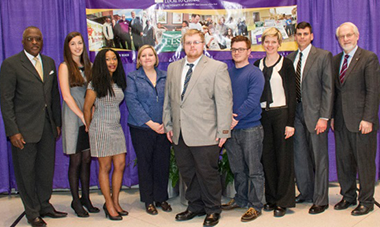After the Foster Care is Over
 |
|
Representatives from the Center for Technology in Government and the state’s Office of Children and Family Services accept the President’s Award for Exemplary Public Engagement from President Robert Jones and Provost James Stellar for the creation of a peer-caller program that has greatly enhanced New York State’s ability to track young people after they leave foster care.
(Photo by Mark Schmidt)
|
ALBANY, N.Y. (December 14, 2015) — By 2010, more than 35,000 youth per year were leaving foster care, after which government could keep little or no track of what was happening to them in terms of employment, education, health, and other factors.
Responding that year, the federal Administration for Children and Families created the National Youth in Transition Database (NYTD), so that all states would begin to uncover these outcomes for post-foster care youth, aged 14-21.
In New York, the State Office of Children and Family Services (OCFS) quickly turned to the University’s Center for Technology in Government (CTG) to administer the NYTD outcomes survey to the first full five-year cohort of former foster care youth, at ages 17, 19, and 21. OCFS knew that CTG had the technology and capabilities to run Internet and paper surveys and create a database for such a large and intricate project.
This September, CTG completed its data collection process of the NYTD surveys for Cohort 1 and submitted it to OCFS. It also worked with OCFS to identify a new project lead that could build upon the technological infrastructure, liaisons network, and NYTD brand that CTG had constructed since 2010. Chosen was UAlbany’s Center for Human Services Research (CHSR), with expertise in the area of child welfare and a past positive working relationship with OCFS.
CTG leaves the project with a highly satisfied partner. “CTG’s dedicated efforts have been pivotal in helping OCFS understand how independent living services are being administered and whether they are helping young people achieve success,” said Laura Velez, Deputy OCFS Commissioner of Child Welfare and Community Services. “OCFS is honored to have partnered with them in implementing this worthy initiative.”
The effort was not without challenges. Many youths were unaware of the NYTD survey, and, so, reluctant to fill it out. With youth in this population tending to move frequently or change their contact information, it was also difficult to conduct the full series of surveys — which consisted of data from youths at age 17, again when that cohort turned 19, and a final follow up at age 21 — over the five years.
CTG responded by creating a new component to the project: the NYTD Peer Caller Program. Using current foster care youths to lead outreach efforts to the post-foster care youth being surveyed, trust and empathy were established. The NYTD Peer Caller Program received the University’s President’s Award for Exemplary Public Engagement.
Data collected from the NYTD surveys can now be used to help inform policy and practice surrounding transition planning, anticipating the needs of youth once they leave care, and understanding what circumstances may predispose a foster youth to certain outcomes such as incarceration or homelessness.
CTG and CHSR worked together this year to prepare CHSR for assuming lead oversight of the NYTD project, which now enters Cohort 2. The transition was completed in August. CHSR will leverage its own 20-year history of conducting evaluation research and designing information systems, as well as an established strong relationship with OCFS, to build upon the products and relationships that CTG helped to create.
“CHSR is pleased to begin leading the NYTD project to ultimately improve the outcomes for youths transitioning from foster care into independence,” said Sarah Rain, a CHSR senior research support specialist. “Over the past five years, the Center for Technology in Government has constructed the technological infrastructure, liaisons network, and established NYTD brand — all of which are components that CHSR looks forward to expanding,”
![]() For more news, subscribe to UAlbany's RSS headline feeds
For more news, subscribe to UAlbany's RSS headline feeds
A comprehensive public research university, the University at Albany-SUNY offers more than 120 undergraduate majors and minors and 125 master's, doctoral and graduate certificate programs. UAlbany is a leader among all New York State colleges and universities in such diverse fields as atmospheric and environmental sciences, business, education, public health,health sciences, criminal justice, emergency preparedness, engineering and applied sciences, informatics, public administration, social welfare and sociology, taught by an extensive roster of faculty experts. It also offers expanded academic and research opportunities for students through an affiliation with Albany Law School. With a curriculum enhanced by 600 study-abroad opportunities, UAlbany launches great careers.


